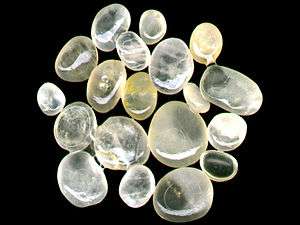Cape May diamonds
Cape May diamonds (sometimes capitalized "Diamonds") are quartz pebbles found on the beaches of Cape May Point, New Jersey. The pebbles are sometimes collected, cut and polished to resemble diamonds, then sold locally as souvenirs. Cape May diamonds are usually collected by beach combing and are most abundant at Higbee (sometimes, Higby's) and Sunset beaches in Cape May. Cape May diamonds range in size from the finest sand to a 3-pound-14-ounce (1.8 kg) "Cape May diamond" found in New Castle, Delaware in 1866.[1] In the 1960s a small intact quartz crystal was found at Sunset Beach which showed almost no signs of rounding by erosion. This dispelled some early myths of their source which included a large boulder of quartz offshore.

Origin
Cape May diamonds are actually pieces of quartz washed down, and worn smooth in the process, from the upper Delaware River.[1] Apocryphally, the trip takes thousands of years.[2][3] However, geologists suggest the pebbles are local in origin, washing out of nearby Pleistocene gravel deposits.[4][5] Cape May diamonds are sometimes incorrectly described as river-smoothed glass discarded by the New Jersey's once-thriving glass manufacturing industry.
Historical relevance
The Native American tribe called the Kechemeche resided in what is now the southern portion of Cape May County, New Jersey. Various sources attribute the Kechemeche with being the first to find Cape May diamonds and then using them as gifts or for trading with other tribes and with the newly arriving European colonists.
See also
- Herkimer diamonds, another form of quartz referred to as "diamonds"
Works cited
- "Diamonds are forever". Backpacker. 15 (81). July 1987. Retrieved 25 November 2011.
-
Doug Hunsberger (2009-05-05). "Cape May's Sparkling Stones: Cape May diamonds are not diamonds at all, but they have been known to fool the most discriminating eyes". New Jersey Monthly. Retrieved 2017-03-03.
Thus begins a journey of more than 200 miles that takes thousands of years to complete.
- Sutton, Clay (2006). Birds and Birding at Cape May. Stackpole.
- State of New Jersey Department of Environmental Protection (1981). New Jersey Shore Protection Plan (Volume 2 Basis and Background).
- New Jersey Geological Survey (1857). Geology of the County of Cape May, State of New Jersey. Printed at the office of the True American. pp. 26.
diamonds.